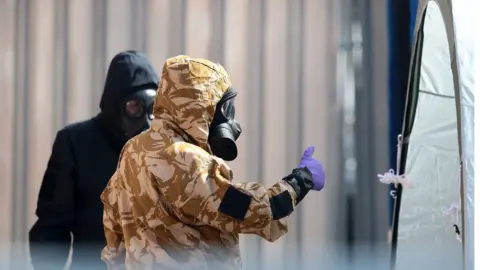Novichok: Why nerve agent stays deadly for so long
 Getty Images
Getty ImagesPolice have said they believe Novichok could remain a threat for up to 50 years if left in a sealed container. What do we know about how long the nerve agent poses a danger?
The death of Dawn Sturgess is a potent reminder of just how dangerous Novichok is and why it is vital to work out how she came into contact with it.
Police are searching for a contaminated container they think was handled by Ms Sturgess and her partner Charlie Rowley - who remains critically ill in hospital.
Counter-terror chief Neil Basu said it was "implausible" the poisoning was not linked to the attack on former Russian spy Sergei Skripal and his daughter Yulia in early March.
But with no guarantee that all traces of Novichok have been found, what is known about how long it lasts?
How nerve agents work
All nerve agents poison in the same way, which is to inhibit the enzyme involved in regulating the body's messages along nerves and between nerves and muscle.
The effect is devastating, with muscles compromised and nerves linked to other organs rendered ineffective.
Glands also stop working properly and breathing becomes more difficult.

How badly affected people are varies greatly - for example, some people are able to break down the chemicals three times as fast as others.
The dose received and how long it takes to get medical treatment also influences how sick people become.
How healthy someone is also makes a big difference - the more robust someone is, the better able they are to cope.
How long Novichok lasts
So what do we know about Novichok and how long it remains in the environment?
Regrettably, very little.
There is insufficient scientific data to be certain about the time it takes for this chemical to degrade and for the threat it poses to end.
Some people have suggested that it disappears relatively quickly and that the poisoning of Ms Sturgess and Mr Rowley is therefore a separate attack to the one on the Skripals.
But that would be jumping to conclusions.
 Metropolitan Police
Metropolitan PoliceNerve agents fall into two categories in terms of how long they remain in the environment.
"Less persistent" nerve agents - those that degrade more quickly - include a range of chemical weapons put into munitions for battlefield use.
These substances - including tabun and sarin - are broken down by water and can evaporate.
Because they can form vapours, they pose a danger through inhalation.

You may also be interested in:

"More persistent" nerve agents were produced to enable the military to contaminate areas for some time - thereby denying access to the enemy unless suitably clothed in protective gear.
The recent hot weather in the UK illustrates how difficult it would be for soldiers to operate in such an environment.
Those involved in searching for the Novichok container were able to remain in their protective suits for only about 30 minutes at a time.
This group of nerve agents includes VX. They do not vaporise as easily and are what is referred to as a "contact-hazard".
Uptake through the skin happens with all nerve agents but is the likely route of exposure for these "persistent agents".
The chemical structure of what has been published about Novichok places this chemical in the more persistent category.
And if stored in any container, the amount of time it remains a danger would be extended.
Novichok: What we know so far
- The phrase "Novichok" applies to a group of advanced nerve agents - highly toxic chemicals that prevent the nervous system from working properly and can be fatal
- Nerve agents will take effect within minutes or even seconds if inhaled and slightly more slowly if exposure is the result of skin contamination
- Novichok means "newcomer" in Russian and was developed by the Soviet Union in the 1970s and 1980s
- Some versions of Novichok are thought to be five to eight times more toxic than the VX nerve agent the US says was used to kill North Korean leader Kim Jong-un's brother last year
But even the "non-persistent" agent sarin can hang around.
In 1992, I was part of a team collecting soil and bomb fragments from a site in Iraq, four years after a bomb had exploded.
We found sarin under a fleck of paint on a bomb fragment.
We were lucky, if you like, in our find - the agent was still present because it was a site of high contamination.
This also explains why inspectors from the Organisation for the Prohibition of Chemical Weapons have found sarin in Syria, months after the detonation of munitions.
The police investigating the murder of Dawn Sturgess and the poisoning of Charlie Rowley and the Skripals face a daunting task.
But they are being advised by very knowledgeable experts who are well aware of the dangers the Novichok agent poses.
And no reminder is needed of how important it is to find the nerve agent "container" or other source of this latest poisoning.

About this piece
This analysis piece was commissioned by the BBC from an expert working for an outside organisation.
Alastair Hay is emeritus professor of environmental toxicology, at the University of Leeds. He is a member of the Organisation for the Prohibition of Chemical Weapons's advisory board on education and outreach and joint winner of the 2015 OPCW -The Hague Award for outstanding contributions towards preventing the use of chemical weapons.

Edited by Duncan Walker
